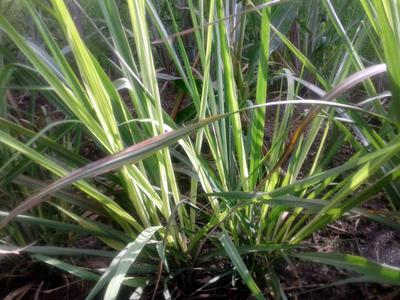Grassy Shoot of Sugarcane
Sugarcane grassy shoot phytoplasma
Bakteria
Kwa Ufupi
- Narrow and pale leaves.
- Grassy appearance of the infected plant.
- Stunted tillers.
Inaweza pia kupatikana kwenye
Dalili
First symptoms appear in a juvenile stage when the crop is of 3-4 months age. Young leaves become pale in colour and appear thin and narrow. As the disease progresses, all new tillers grow in white or yellow colour, giving the plant a grassy appearance. The affected clumps are stunted with premature proliferation of auxillary buds. Secondary infection on full-grown canes shows side sprouting and yellowing. Generally, diseased plants raised from infected setts do not produce millable canes and a number of clumps usually fail to sprout after harvest, producing gaps in the ratoons. If canes are formed, they appear thin with shorter internodes, having aerial roots at the lower nodes. The buds on such canes are usually papery and abnormally elongated.
Mapendekezo

Udhibiti wa Kiasili
Direct treatment of this disease is not possible. However, aphids, being the main vector of Grassy shoot in sugarcane, can still be controlled. In the case of mild infestation, use a simple soft insecticidal soap solution or solutions based on plant oils.

Udhibiti wa Kemikali
Always consider an integrated approach with preventive measures together with biological treatments, if available. There is no chemical control to combat the disease directly, but insecticides can be used if critical numbers of aphids or leafhoppers are found. Products based on Dimethoate (@ 1 ml/l water) or Methyl-demeton (@ 2 ml/l water) (Aphids) can be sprayed twice with a monthly interval.
Ni nini kilisababisha?
The disease is caused by bacteria-like organisms called phytoplasma. Primary transmission of the phytoplasma is through infested seed material (setts). Secondary transmission happens through phloem-feeding insects, especially leafhopper and aphids as well as dodder, a root parasite. It can also be transmitted mechanically by cutting knives. Sorghum and maize are alternative hosts for the disease. The symptoms have similarities with those of iron deficiency but appear in random, isolated areas on your field.
Hatua za Kuzuia
- Use only healthy seeds and consider planting resistant varieties, such as Co 86249, CoG 93076 and CoC 22.
- To eliminate the pathogene from your seed material, treat your infected seed material either with hot water at 50°C for 2 hours or with moist air (54°C for 2½ hours).
- You might treat your seed material with a 500 ppm solution of ledermycin (an antibiotic) before planting.
- Monitor your field regularly for symptoms of the disease and/or the insect.
- If you detect affected plants within two weeks after planting, you can still replace them with healthy plants.
- Remove affected plants and destroy them immediately by burning.
- Use yellow sticky traps to control insect vectors like aphids.
- Crop rotation may reduce inoculum in your field.



